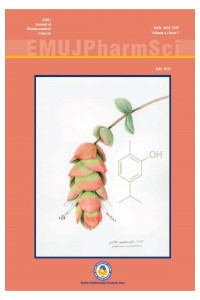Adsorption of iron, lead, paracetamol, imipramine on natural polymers
Adsorption of iron, lead, paracetamol, imipramine on natural polymers
Chitosan, decontamination, hemocompatibility, imipramine, iron lead, paracetamol, pectin, starch,
___
- Adali T, Yilmaz E (2009). Synthesis, characterization and biocompatibility studies on chitosan-graft-poly (EGDMA). Carbohydr. Polym. 77:136–141.
- Bahramzadeh E, Yilmaz E, Adali T (2019). "Chitosan-graft-poly (N-hydroxy ethyl acrylamide) copolymers: Synthesis, characterization and preliminary blood compatibility in vitro." Int J Biol Macromol 123: 1257-1266.
- Baranwal AK, Singhi SC (2003). Acute iron poisoning: management guidelines. Indian Pediatr 40(6): 534-540.
- Brush DE, Aaron CK (2007). Tricyclic and other cyclic antidepressants. In: Shannon MW, Borron SW, Burns MJ, eds. Haddad and Winchester's Clinical Management of Poisoning and Drug Overdose. 4th ed. Philadelphia, Pa: Saunders Elsevier.
- Caner H, Hasipoglu H, Yilmaz O, Yilmaz E (1998). Graft copolymerization of 4- vinylpyridine on to chitosan-1, by ceric ion initiation. Eur. Polym. J. 34: 493–497.
- Caner H, Yilmaz E, Yilmaz O (2007). Synthesis, characterization and antibacterial activity of poly (N-vinylimidazole) grafted chitosan. Carbohydr. Polym. 69:318–325
- Crowl DA, Louvar JF (2001). Chemical process safety: fundamentals with applications Pearson Education.
- Geiger A, Cooper J (2010). Overview of airborne metals regulations, exposure limits, health effects, and contemporary research. Environmental Protection Agency, Air Quality: Washington, DC, USA.
- Haddad LM, Shannon MW, Winchester JF (1983). Clinical Management of Poisoning and Drug Overdose. 3rd Edition.
- Hasipoglu HN, Yilmaz E, Yilmaz O, Caner H (2005). Preparation and characterization of maleic acid grafted chitosan. Int. J. Polym Anal Charact 10: 313–327.
- Järup L (2003). Hazards of heavy metal contamination. Br Med Bull 68(1):167-182.
- Prescott LF (1983). Paracetamol overdosage. Pharmacological considerations and clinical managemente. Drugs 25(3): 290-314.
- Yilmaz E, Adali T, Yilmaz O, Bengisu M (2007). Grafting of poly (triethylene glycol dimethacrylate) onto chitosan by ceric ion initiation. React Funct Polym 67:10–18.
- Yilmaz E, Yalinca Z, Yahya K, Sirotina U (2016). pH responsive graft copolymers of chitosan. Int J Biol Macromol 90:68–74.
- ISSN: 2651-3587
- Başlangıç: 2018
- Yayıncı: Doğu Akdeniz Üniversitesi
Gönül ŞAHİN, Sonia SANAJOU, Hananeh KORDBACHEH
Adsorption of iron, lead, paracetamol, imipramine on natural polymers
Gönül ŞAHİN, Sonia SANAJOU, Reihaneh BEHNOUSH, Ehsan BAHRAMZADE
INVESTIGATION OF STREPTOCOCCUS PYOGENES CARRIAGE AMONG PHARMACY STUDENTS IN CYPRUS
Sahar HADDAD, Mehmet İLKTAÇ, Sultan OGMEN, Gülden ÇELİK
Açelya MAVİDENİZ, Amirhossein FALLAH, Foroogh KOSHRAVİ, Farimah AHDNO, Mehmet ARTER, Tuğba ERÇETİN, Mustafa Fethi SAHİN, Hayrettin Ozan GÜLCAN
